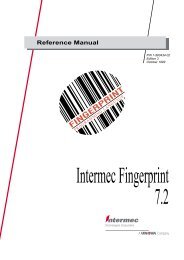9560 Transaction Manager User's Manual - Intermec
9560 Transaction Manager User's Manual - Intermec
9560 Transaction Manager User's Manual - Intermec
Create successful ePaper yourself
Turn your PDF publications into a flip-book with our unique Google optimized e-Paper software.
<strong>9560</strong> <strong>Transaction</strong> <strong>Manager</strong> User’s <strong>Manual</strong><br />
5-8<br />
User-Defined and User-Defined Multi-Drop Protocols<br />
You define all protocol parameters in User-Defined protocols. Thus, you can<br />
duplicate any protocol to emulate a proprietary or irregular protocol on a host<br />
computer.<br />
Some protocols are very robust and secure, while others are not. A secure data<br />
link protocol can recover from transmission line errors (parity and framing<br />
errors) and uses affirmative and negative responses to verify communication<br />
events. If the transmitting device receives a negative acknowledgment, the data<br />
is retransmitted. The maximum retry count is three for all asynchronous<br />
<strong>Intermec</strong> protocols.<br />
Tips for Defining Secure Protocols<br />
Use these tips for defining secure User-Defined protocols:<br />
1. Define all protocol fields with ASCII control characters. See the Glossary for<br />
definitions of unfamiliar acronyms and terms. Examples:<br />
SOM = STX REQ = ENQ<br />
AFF = ACK RES = EOT<br />
NEG = NAK EOR1 = RS<br />
EOM1 = ETX EOF = ETB<br />
2. Use even or odd parity when transmitting data.<br />
3. Enable the LRC (Longitudinal Redundancy Check character) to provide<br />
added data security to all transmitted and received messages. When both<br />
parity and LRC checks are enabled, horizontal and vertical error checking<br />
are performed. If the SOM is enabled, it is not included in the LRC<br />
calculation. The reader allows the LRC to be enabled in addition to<br />
XON/XOFF flow control. The host device must also be able to receive the<br />
XON or XOFF character as the LRC or receive the XON or XOFF characters<br />
as data if preceded by the DLE.<br />
4. If the host device cannot guarantee reception of data at all times, the host<br />
should control the transmission of data from the reader. There are three<br />
methods available. Use one of the methods or combine them:<br />
a. Enable Solicitation. This prohibits the reader from sending any type of<br />
data or response unless the host is ready for it.<br />
b. Enable XON/XOFF flow control.<br />
c. Use CTS (clear to send) hardware handshake. The reader checks CTS<br />
before transmitting all characters with the exception of XON/XOFF<br />
responses. If CTS is false, the reader either stops or does not start<br />
transmitting data.<br />
5. Always enable the SOM.
















